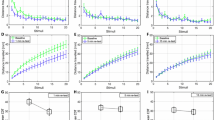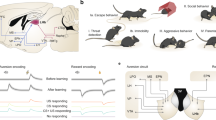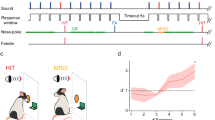Abstract
HABITUATION, defined as a “waning of a response as a result of repeated stimulation”1, can be considered to be a form of learning if fatigue, injury and local sensory adaptation can be ruled out. This is the case when an organism shows the same behaviour response to a different or more intense stimulus after habituation. The usual way to ascertain whether there is local sensory adaptation is by recording electrically the relevant sensory pathways; this is often quite difficult, either because the nerves are too small or are too numerous to record from. It is possible to design behavioural experiments to test for non-local habituation; among the invertebrates1, however, this is only possessed by planarians2.
This is a preview of subscription content, access via your institution
Access options
Subscribe to this journal
Receive 51 print issues and online access
$199.00 per year
only $3.90 per issue
Buy this article
- Purchase on SpringerLink
- Instant access to full article PDF
Prices may be subject to local taxes which are calculated during checkout
Similar content being viewed by others
References
Thorpe, W. H., Learning and Instinct in Animals (Methuen, London, 1963).
Westerman, R. A., Science, 140, 676 (1963).
Applewhite, P. B., and Morowitz, H. J., Yale J. Biol. and Med., 39, 90 (1966).
Clark, A. M., J. Exp. Biol., 22, 88 (1946).
Author information
Authors and Affiliations
Rights and permissions
About this article
Cite this article
APPLEWHITE, P. Non-local Nature of Habituation in a Rotifer and Protozoan. Nature 217, 287–288 (1968). https://doi.org/10.1038/217287a0
Received:
Published:
Issue date:
DOI: https://doi.org/10.1038/217287a0
This article is cited by
-
Theory of Protozoan Habituation
Nature New Biology (1971)
-
Similarities in Protozoan and Flatworm Habituation Behaviour
Nature New Biology (1971)
-
Protozoan Habituation Learning after Loss of Macronuclei and Cytoplasm
Nature (1969)
-
Temperature and Habituation in a Protozoan
Nature (1968)
-
RNA Changes during Protozoan Habituation
Nature (1968)



